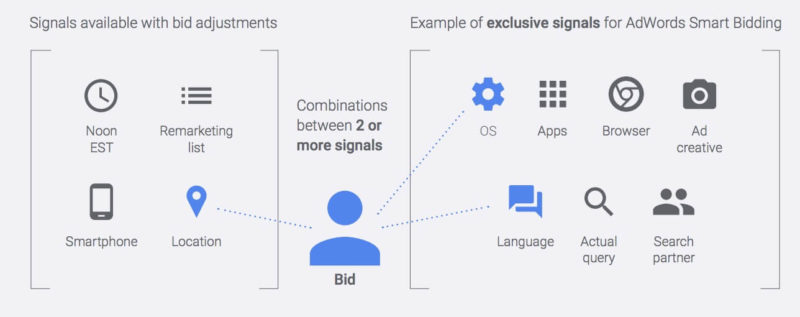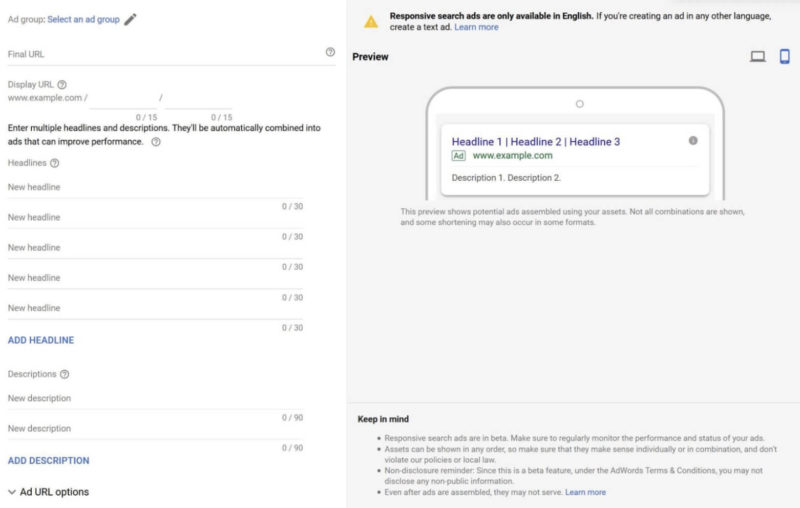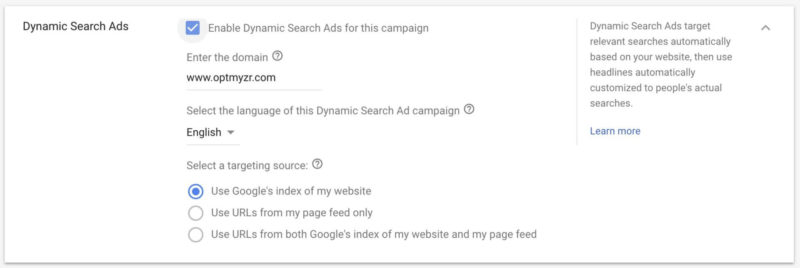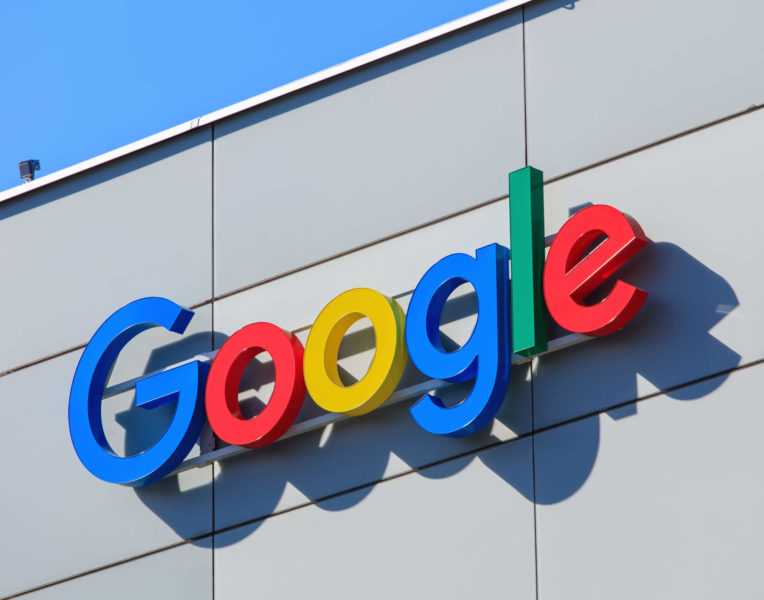Google Ads (formerly known as AdWords) has always had frequent product updates, but with the ongoing improvements in machine learning (ML), it seems that every month brings new automated features, in addition to the manual features we’ve come to expect.
These automations are exciting because they promise similar results with less work. But machines can’t do everything pay-per-click (PPC) professionals can, and machines and humans are often at their best when they work together.
So, to help you better understand what is possible with today’s crop of Google Ads automated tools, here is a rundown of what Google Ads offers, how the automation works and what account managers can do to further improve results.
Smart campaigns for small business
Along with Google’s recent rebranding of AdWords to Google Ads, they announced the arrival of a new automated campaign type for small businesses, called Smart Campaigns. This campaign type, now available in the US, is built on top of AdWords Express, and according to Google, it can produce significantly better results.
For now, this will become the default campaign type for new advertisers. The target users of this type of campaign might have chosen AdWords Express or Local Service Ads in the past, and those options will remain available until further notice from Google.
If a small business decides to work with an agency or wants to venture into PPC management, it can still opt for the full Google Ads experience. This means they can choose from varying levels of automation and make decisions about where to trade off using machine learning to drive results with manual management that provides more control.

Image courtesy Google.com. Smart Campaigns in Google Ads
What is automated
In addition to automatic targeting (across all Google properties) and automated goals-based bidding, Smart Campaigns will soon automate ad and landing page generation based on data from Google My Business (GMB), along with some user-selected images. This is yet another step in how structured data management (i.e., managing your business details in GMB) is becoming a critical skill to master in online advertising.
What still needs to be done manually
Budgets, target location and language can be managed by the advertiser, but realistically, these won’t change often after a campaign is set up so management will be fairly minimal. As a simple entry point into Google Ads, it is conceivable that the superior results promised by this campaign type will entice advertisers to explore more options and venture into the more traditional campaign types when they are ready to do even more with digital marketing.
Universal app campaigns
Launched in May 2015, Universal App campaigns are an automated campaign type that helps advertisers get more installs of their app or drive in-app conversions. As far as I can remember, it is the earliest fully automated campaign type in Google Ads. Once it’s set up, there are very few things for advertisers to optimize. This is somewhat unusual, in that most automation from Google is launched in addition to existing manual options to achieve the same thing.

Image courtesy Google. Universal app campaign
What is automated
Google manages bidding, targeting and creatives and works to achieve the maximum results for the desired goal within the budget set by the advertiser. The system leverages the structured data from the advertiser’s app listing on Android or iOS to automate creative elements.
What still needs to be done manually
To start a Universal App campaign, advertisers select a daily budget, a target cost per result and location and language targets. Google also asks for a few ad text ideas and optionally, images, videos and HTML5 assets to give their automated ad-generation system some ideas for a starting point.
Because the creatives are derived from an app’s listing in the app store, advertisers who improve their listings will see their optimizations reflected in their app campaigns. Just as with the aforementioned Smart Campaigns, managing structured data (i.e., managing the app’s listing) is becoming a more critical component of optimization.
Goal-optimized Shopping campaigns
Just the way Smart Campaigns are simplifying getting online for small businesses, this new campaign subtype makes it easier for retailers to get started with Shopping ads, the ad format that is now responsible for 60 percent of all clicks on Google for retailers.
At my company, Optmyzr, we work with a lot of retailers, and it’s clear that managing Shopping ads for tens of thousands of products is a significant undertaking. So, it makes sense that Google is trying to make it easier for more advertisers to take advantage of Shopping ads by making management more automated.

Image courtesy Google. Goal-based Shopping campaign
What is automated
This campaign automatically runs product Shopping ads and remarketing ads on the Google display network and uses data from at least 20 conversions over the last 45 days to predict the bids that will achieve the maximum sales value. Advertisers can set an optional return on advertising spending (ROAS) target, and the system will work to maximize the sales within the given budget and ROAS target.
What still needs to be done manually
Google recommends having separate campaigns if you have different ROAS targets. Remember that maximizing conversion value is not the same as maximizing profits. You probably have different margins on different products, and margins can fluctuate, so managing ROAS targets through separate campaigns may improve results.
Also be cautious about incrementality from remarketing. As explained by Andreas Reiffen in his session at SMX Advanced, results that include remarketing data can make the numbers look better than they really are. Because this automated campaign can show remarketing ads, it is important to closely analyze how many new customers it is delivering, as opposed to targeting users who would likely have returned on their own.
As with the previous two automatic campaign types, this one also shifts some of the optimization opportunities into managing the structured data, in this case, what is in the Shopping feed.
Automated bidding
There are seven automated bidding strategies from Google that help advertisers reach a variety of business goals with minimal work. Three of these are based on Smart Bidding, a mechanism whereby Google uses machine learning to predict which clicks are most likely to drive conversions and conversion value.
Automated bidding is perhaps a bit of a misnomer because, while it automates aspects of bid management, it should not be thought of as fully automated. Google even states in their bidding white paper that targets should be adjusted for factors that its automation doesn’t consider.
Over the years, Google Ads (formerly Adwords) bid management has evolved from a Max cost per click (CPC) system to a target-based system. Targets could be for things like cost per action(CPA), ROAS or outranking specific competitors.
Because these targets are more closely aligned with typical business goals, they remove the need for additional calculations that advertisers used to do manually. But, because targets can change based on factors that Google has no insight into, these automated bid systems will still perform best when managed by people who are aware of what’s happening in the business.

Image courtesy Google. The factors used by bidding automation
What is automated
In the case of Smart Bidding strategies like Target CPA, Target ROAS and Enhanced CPC, Google automatically predicts the likelihood of conversions by looking at auction-time signals including device, location, language, dayparts and more. These predictions feed the automated bids that are used for every unique auction.
What still needs to be done manually
While Google can predict changes in conversion rate and conversion value based on a variety of factors that are widely applicable across a range of advertisers, these systems don’t yet consider unique factors that impact individual advertisers. This means that advertisers should supplement “automated” bid strategies with a management methodology that changes targets based on business-specific conversion factors.
Things like flash sales, coverage in the media, weather, social media buzz and so on can all impact how an ad campaign converts, but these factors may not be apparent to Google’s machine learning, so the advertiser who is aware of these factors must do active bid management. But instead of managing things by changing a max CPC bid, management now entails changing the target.
Responsive search ads
Writing ads is the most creative aspect of PPC, and while coming up with compelling offers and text is still the work of PPC pros, Google is making ad testing more automated.
With their recent introduction of Responsive search ads, advertisers can now submit a variety of headlines and descriptions and leave it to Google Ads to come up with winning combinations.
This is similar to responsive ads for display, where Google generates ad variants automatically from pieces of text and images.

Image courtesy Google. Responsive search ads.
What is automated
After submitting several ad text components, Google combines these into ads and measures which combinations work best. The ad-serving system will then try to show the best ads for each query.
What still needs to be done manually
Writing engaging ad components still has to be done by humans. A decade ago, when I was still working at Google, we ran an experiment where the system automatically wrote ads for local businesses. But the experiment was ended because all ads started looking the same, and that made it impossible for Quality Score to favor higher-quality ads. It turned out that automating creatives caused evolution amongst ads to come to a grinding halt and was actually counterproductive to the whole ecosystem.
So long as we learn from writing the occasional bad ad, it’s still really good for humans to come up with new ideas.
Dynamic Search Ads
For advertisers with large sites or who sell lots of different products, it can be challenging to keep search ads in sync with what they currently offer. Dynamic Search Ads (DSAs) offer an automated solution that targets ads to relevant queries, with relevant ads and the right landing page. It does this by using Google’s organic index to find instances when a page on an advertiser’s site would be a good match for a search but is not triggering any ads in Google Ads.

What is automated
The advertiser can choose whether to include all pages from their site that are in the Google index or just those pages that are in a feed. From that point, Google automatically targets the ads and shows ads with an automated headline.
What still needs to be done manually
Bids can be automated using a bidding strategy, but, unlike goal-based campaigns like Smart Campaigns, Goal-Based Shopping Campaigns, and Universal App Campaigns, it is still possible to manage bids manually. As with some of the automated campaign types, optimization can be shifted away from Google Ads and into managing structured data — in this case, your website.
Conclusion
Besides what I’ve covered, there are other automations in Google Ads. Automatic ad extensions, optimized ad rotation, and even using broad match to automatically show ads on related queries are forms of automation that help reduce the amount of time that’s needed to manage a successful campaign.
Things that are automated are now typically getting the word “Smart” put in front of the name, e.g., Smart Campaigns, Smart Bidding and so on. It kind of reminds me of the days of SmartASS, the old internal name for Quality Score, one of Google’s earliest forays into machine learning with its ads products.
On July 10, Google will host Google Marketing Live, its annual launch event for new ads and analytics products, and they’ve already hinted at additional new campaign types that will leverage machine learning to further simplify campaign management.
Be sure to watch the livestream and the post-show, where I will join Googlers to share my impressions about what was announced and how their latest changes can be used by PPC practitioners.
Opinions expressed in this article are those of the guest author and not necessarily Search Engine Land. Staff authors are listed here.

